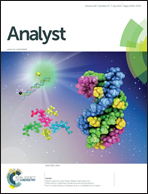A strategy for analyzing bond strength and interaction kinetics between Pleckstrin homology domains and PI(4,5)P2 phospholipids using force distance spectroscopy and surface plasmon resonance†
Abstract
Phospholipids are important membrane components involved in diverse biological activities ranging from cell signaling to infection by viral particles. A thorough understanding of protein–phospholipid interaction dynamics is thus crucial for deciphering basic cellular processes as well as for targeted drug discovery. For any specific phospholipid–protein binding experiment, various groups have reported different binding constants, which are strongly dependent on applied conditions of interactions. Here, we report a method for accurate determination of the binding affinity and specificity between proteins and phospholipids using a model interaction between PLC-δ1/PH and phosphoinositide phospholipid PtdIns(4,5)P2. We developed an accurate Force Distance Spectroscopy (FDS)-based assay and have attempted to resolve the problem of variation in the observed binding constant by directly measuring the bond force. We confirm the FDS findings of a high bond strength of ∼0.19 ± 0.04 nN by Surface Plasmon Resonance (SPR) data analysis, segregating non-specific interactions, which show a significantly lower KD suggesting tight binding.


 Please wait while we load your content...
Please wait while we load your content...